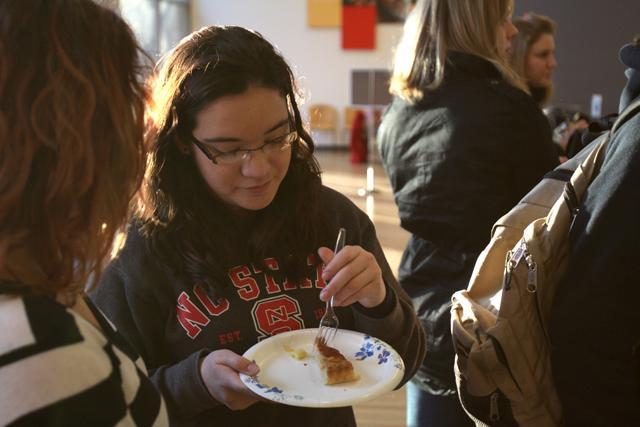
© 2012 NCSU Student Media
Joyska Nunez, a freshman history major, eats cake at the Fete de Rois in Caldwell Lounge on January 18th. Photo by Chris Phipps.
A group of American and French students gathered in the spacious lounge in Caldwell Hall to celebrate La Fete des Rois last Wednesday evening.
“It’s a celebration for epiphany,” said Joyska Nunez, a freshman in history.
On one table sat a plate littered with crumbs, the only remnants of the galette des rois , the traditional food eaten during the celebration. Nunez held the feve , the traditional idol that is planted within the galette and given to whoever has it in their piece of the cake.
“The tradition is to have a cake with a feve , and the person who gets the piece is crowned the king or queen,” Nunez said.
This tradition originated in France as a celebration for the epiphany of the three kings, or magi, who presented Jesus with the gifts of gold, frankincense, and myrrh upon his birth. The holiday thus came to be known as La Fete des Rois , or the Festival of the Kings, and was celebrated with a cake, into which a small, religious figure was baked.
Whoever finds this figure in the cake becomes king or queen for the day and has the right to pick their partner in royalty.
“I liked to pick the cutest boy,” said Alissa Auquier , a French student studying U.S . Culture and Education.
Though the holiday began as a religious celebration centered around the birth of Christ, much like Christmas in the United States, La Fete des Rois has become more and more of a secular holiday. The feve , one of the more recognizable symbols of this celebration, have begun to take on this more earthly, rather than spiritual, tone.
“People like them so much they collect them,” said Martin Bell, a senior lecturer in French language and culture.
Bell herself has collected a tiny, ceramic wheel-barrow which she had used in years passed as a feve for her galettes .
Despite the loss of religious fervor for the holiday, it is still a highly anticipated day in France, especially among the youth. Each year as the cake is being cut and parceled out to the family, the youngest child crawls under the table and tells the cake cutter who to give each piece to, so that the feve will be given out at random, according to Bell.
“For a kid, it’s exciting,” said Valentine Landreau , a French student studying U.S . Culture and Education.
However, on January 18, college students not only got to share that excitement so familiar to the French but they also got to share the simple excitement of sharing different cultural traditions amongst friends.